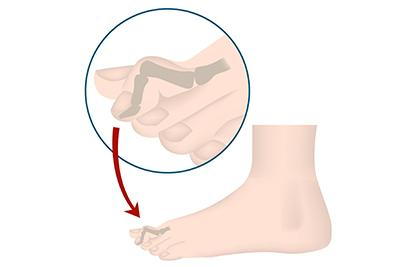Hammertoes: Causes, Symptoms, and Treatment Options

- posted: Jul. 25, 2024
Hammertoes refer to a foot problem that causes a bend in a toe or toes. Hammertoes typically impact the second, third, fourth, or fifth toe. According to Dr. Brandi Myers of Sellwood Podiatry in Southeast Portland, OR, it is essential to see a podiatric professional if you have enduring foot pain that impacts your ability to walk.
Hammertoes Symptoms
Hammertoe symptoms include:
- Pain when wearing certain types of shoes.
- It is challenging to move impacted toe(s).
- Redness/swelling.
- Toe stiffness.
- Progression of corns/calluses from rubbing and creating painful symptoms.
Hammertoes Causes
The common causes of hammertoes include the following:
- Foot Structure or Genetics
A foot’s structure or shape (referring to flat feet or high arches, etc.) may predispose an individual to develop hammertoes. Additionally, research suggests that there appears to be a genetic component in which hammertoes tend to run in families. - Muscle Imbalance
A muscle imbalance controlling the impacted toe is often a common cause of a hammertoe because this imbalance tends to pull or curl the toe into an abnormal position–causing a hammertoe. - Arthritis
Specific types of arthritis—rheumatoid arthritis and osteoarthritis—can affect the toe joints, creating inflammation and eventually causing hammertoes. - Toe Trauma or Injury
Any toe injury or trauma, such as stubbing a toe, can cause joint damage and the progression/development of a hammertoe. - Aging
As people age, their ligaments and tendons tend to become less flexible. This makes the aging process a common contributing factor to the development of hammertoes. - Nerve Damage
Neuropathy, a.k.a. nerve damage, is a common condition often related to diabetes. Nerve damage can impact the tendons and muscles in the feet, causing an imbalance and ultimately contributing to hammertoe formation. - Ill-Fitting Footwear
High heels or shoes with high heeling (referring to footwear that compresses the toes abnormally) increase the likelihood of hammertoe development.
Hammertoes Treatment Options
Conservative podiatric treatment options for hammertoes may include the following:
- Choosing to wear support and comfortable footwear.
- Using orthotic devices/inserts for support.
- Toe stretches and exercises.
- Using toe cushions or splints that help straighten affected toes.
When conservative methods fail to provide the desired relief or outcome in Portland, OR, surgery is a viable option as it allows for the podiatrist to reposition the impacted toe joints and alleviate pain or discomfort.
Contact a Leading Podiatrist
For additional information regarding hammertoes, contact Dr. Myers or a staff member of Sellwood Podiatry in Southeast Portland, OR, at (503) 235-8594.

- posted: Jul. 25, 2024
Hammertoes refer to a foot problem that causes a bend in a toe or toes. Hammertoes typically impact the second, third, fourth, or fifth toe. According to Dr. Brandi Myers of Sellwood Podiatry in Southeast Portland, OR, it is essential to see a podiatric professional if you have enduring foot pain that impacts your ability to walk.
Hammertoes Symptoms
Hammertoe symptoms include:
- Pain when wearing certain types of shoes.
- It is challenging to move impacted toe(s).
- Redness/swelling.
- Toe stiffness.
- Progression of corns/calluses from rubbing and creating painful symptoms.
Hammertoes Causes
The common causes of hammertoes include the following:
- Foot Structure or Genetics
A foot’s structure or shape (referring to flat feet or high arches, etc.) may predispose an individual to develop hammertoes. Additionally, research suggests that there appears to be a genetic component in which hammertoes tend to run in families. - Muscle Imbalance
A muscle imbalance controlling the impacted toe is often a common cause of a hammertoe because this imbalance tends to pull or curl the toe into an abnormal position–causing a hammertoe. - Arthritis
Specific types of arthritis—rheumatoid arthritis and osteoarthritis—can affect the toe joints, creating inflammation and eventually causing hammertoes. - Toe Trauma or Injury
Any toe injury or trauma, such as stubbing a toe, can cause joint damage and the progression/development of a hammertoe. - Aging
As people age, their ligaments and tendons tend to become less flexible. This makes the aging process a common contributing factor to the development of hammertoes. - Nerve Damage
Neuropathy, a.k.a. nerve damage, is a common condition often related to diabetes. Nerve damage can impact the tendons and muscles in the feet, causing an imbalance and ultimately contributing to hammertoe formation. - Ill-Fitting Footwear
High heels or shoes with high heeling (referring to footwear that compresses the toes abnormally) increase the likelihood of hammertoe development.
Hammertoes Treatment Options
Conservative podiatric treatment options for hammertoes may include the following:
- Choosing to wear support and comfortable footwear.
- Using orthotic devices/inserts for support.
- Toe stretches and exercises.
- Using toe cushions or splints that help straighten affected toes.
When conservative methods fail to provide the desired relief or outcome in Portland, OR, surgery is a viable option as it allows for the podiatrist to reposition the impacted toe joints and alleviate pain or discomfort.
Contact a Leading Podiatrist
For additional information regarding hammertoes, contact Dr. Myers or a staff member of Sellwood Podiatry in Southeast Portland, OR, at (503) 235-8594.
Contact Us
Office & Phone Hours
Monday
9:00 am - 4:00 pm
Tuesday
9:00 am - 4:00 pm
Wednesday
9:00 am - 4:00 pm
Thursday
9:00 am - 4:00 pm
Friday
9:00 am - 4:00 pm
Saturday
Closed
Sunday
Closed